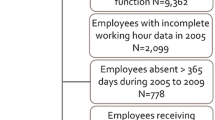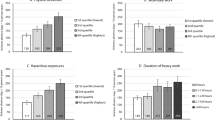Abstract
Purpose
To investigate the association between self-reported exposure to disturbing noise and risk of long-term sickness absence (LTSA) for more than two consecutive weeks among office workers.
Methods
LTSA was measured using register data that were linked to survey data from 2,883 office workers aged 18–59 who were surveyed in 2005 on exposure to disturbing noise. The risk of LTSA was investigated using Cox proportional hazards model.
Results
Of the study population, 4.4 % had LTSA in the 1-year follow-up period. Compared to office workers who were ‘rarely or never’ exposed to disturbing noise at work, office workers who reported being ‘frequently’ exposed to disturbing noise had a significantly increased estimated risk of LTSA when adjusting for age, gender, smoking status, and managerial position (HR = 1.90; 95 % CI, 1.12–3.22). After additional adjustment for psychosocial work conditions, the estimated risk of LTSA for office workers who were frequently exposed to disturbing noise became marginally insignificant (HR = 1.73; 95 % CI, 0.99–3.01). A subgroup analysis showed that women who reported being frequently exposed to disturbing noise had a significantly increased estimated risk of LTSA (HR = 1.94; 95 % CI, 1.04–3.64), whereas the corresponding risk for men was insignificant (HR = 1.28; 95 % CI, 0.37–4.41).
Conclusions
This study indicates that frequent self-reported exposure to disturbing noise at work is associated with increased risk of LTSA among office workers and that this association may be stronger for women than for men.
Similar content being viewed by others
References
Allebeck P, Mastekaasa A (2004) Swedish Council of Technology Assessment in Health care (SBU). Chapter 5. Risk factors for sick leave—general studies. Scand J Public Health 63:49–108
Babisch W (2011) Cardiovascular effects of noise. Noise Health 13:201–204
Banbury S, Berry DC (1998) Disruption of office-related tasks by speech and office noise. Br J Psychol 89:499–517
Beaman CP, Jones DM (1998) Irrelevant sound disrupts order information in free recall as in serial recall. Q J Exp Psychol A 51:615–636
Bengtsson J, Waye KP, Kjellberg A (2004) Evaluations of effects due to low-frequency noise in a low demanding work situation. J Sound Vib 278:83–99
Bluhm G, Nordling E, Berglind N (2004) Road traffic noise and annoyance-an increasing environmental health problem. Noise Health 6:43–49
Bluhm G, Berglind N, Nordling E, Rosenlund M (2007) Road traffic noise and hypertension. Occup Environ Med 64:122–126
Burr H, Bjorner JB, Kristensen TS, Tüchsen F, Bach E (2003) Trends in the Danish work environment in 1990–2000 and their associations with labor-force changes. Scand J Work Environ Health 29:270–279
Christensen KB, Lund T, Labriola M, Bültmann U, Villadsen E (2007) The impact of health behaviour on long term sickness absence: results from DWECS/DREAM. Ind Health 45:348–351
Clausen T, Christensen KB, Lund T, Kristiansen J (2009) Self-reported noise exposure as a risk factor for long-term sickness absence. Noise Health 11:93–97
Davies HW, Teschke K, Kennedy SM, Hodgson MR, Hertzman C, Demers PA (2005) Occupational exposure to noise and mortality from acute myocardial infarction. Epidemiology 16:25–32
Evans GW, Johnson D (2000) Stress and open-office noise. J Appl Physiol 85:779–783
Fogari R, Zoppi A, Corradi L, Marasi G, Vanasia A, Zanchetti A (2001) Transient but not sustained blood pressure increments by occupational noise. An ambulatory blood pressure measurement study. J Hypertens 19:1021–1027
Fried Y, Melamed S, Ben-David HA (2002) The joint effects of noise, job complexity, and gender on employee sickness absence: an exploratory study across 21 organizations—the CORDIS study. J Occup Organ Psychol 75:131–144
Heinonen-Guzejev M, Vuorinen HS, Mussalo-Rauhamaa H, Heikkila K, Koskenvuo M, Kaprio J (2004) Somatic and psychological characteristics of noise-sensitive adults in Finland. Arch Environ Health 59:410–417
Hjollund NH, Larsen FB, Andersen JH (2007) Register-based follow-up of social benefits and other transfer payments: accuracy and degree of completeness in a Danish interdepartmental administrative database compared with a population-based survey. Scand J Public Health 35:497–502
Hobfoll SE (2002) Social and psychological resources and adaptation. Rev Gen Psychol 6:307–324
Hughes R, Jones DM (2001) The intrusiveness of sound: laboratory findings and their implications for noise abatement. Noise Health 4:51–70
Johansen K, Andersen JS, Mikkelsen S, Pass O, Raffnsøe S, Lynge E (2008) Controlling sickness absence: a study of changes in the Danish sickness absence legislation since 1973. Health Policy 86:109–118
Kristensen TS (1991) Sickness absence and work strain among Danish slaughterhouse workers: an analysis of absence from work regarded as coping behaviour. Soc Sci Med 32:15–27
Kristiansen J (2010) Is noise exposure in non-industrial work environments associated with increased sickness absence? Noise Vib Worldwide 41:9–16
Kristiansen J, Mathiesen L, Nielsen PK et al (2009) Stress reactions to cognitively demanding tasks and open-plan office noise. Int Arch Occup Environ Health 82:631–641
Melamed S, Kristal-Boneh E, Froom P (1999) Industrial noise exposure and risk factors for cardiovascular disease: findings from the CORDIS study. Noise Health 1:49–56
Melamed S, Fried Y, Froom P (2004) The joint effect of noise exposure and job complexity on distress and injury risk among men and women: the cardiovascular occupational risk factors determination in Israel study. J Occup Environ Med 46:1023–1032
Miedema HME, Vos H (2007) Associations between self-reported sleep disturbance and environmental noise based on reanalyses of pooled data from 24 studies. Behav Sleep Med 5:1–20
Passchier-Vermeer W, Passchier WF (2000) Noise exposure and public health. Environ Health Perspect 108(Suppl 1):123–131
Pejtersen JH, Kristensen TS, Borg V, Bjorner JB (2010) The second version of Copenhagen Psychosocial Questionnaire (COPSOQII). Scand J Public Health 38(suppl 3):8–24
Pejtersen JH, Feveile H, Christensen KB, Burr H (2011) Sickness absence associated with shared and open-plan offices—a national cross-sectional questionnaire survey. Scand J Work Environ Health 37:376–382
Podsakoff PM, MacKenzie SB, Lee JY, Podsakoff NP (2003) Common method biases in behavioral research: a critical review of the literature and recommended remedies. J Appl Psychol 88:879–903
Rothman KJ, Greendland S (1998) Modern epidemiology, 2nd edn. Lippincott, Williams & Wilkins, Philadelphia, Baltimore
Smith A (2003) The concept of noise sensitivity: implications for noise control. Noise Health 5:57–59
Thorsen SV, Bjorner JB (2010) Reliability of the Copenhagen Psychosocial Questionnaire. Scand J Public Health 38(suppl 3):25–32
van Kempen E, Babisch W (2012) The quantitative relationship between road traffic noise and hypertension: a meta-analysis. J Hypertens 30:1075–1086
van Kempen EEMM, Kruize H, Boshuizen HC, Ameling CB, Staatsen BAM, de Hollander AEM (2002) The association between noise exposure and blood pressure and ischemic heart disease: a meta-analysis. Environ Health Perspect 110:307–317
Waye KP, Bengtsson J, Rylander R, Hucklebridge F, Evans P, Clow A (2002) Low frequency noise enhances cortisol among noise sensitive subjects during work performance. Life Sci 70:745–758
Willich SN, Wegscheider K, Stallman M, Keil T (2006) Noise burden and the risk of myocardial infarction. Eur Heart J 27:276–282
Witterseh T, Wyon DP (2004) The effects of moderate heat stress and open-plan office noise distraction on SBS symptoms and on the performance of office work. Indoor Air 14(Suppl 8):30–40
Conflict of interest
The authors declare that they have no conflict of interest.
Author information
Authors and Affiliations
Corresponding author
Rights and permissions
About this article
Cite this article
Clausen, T., Kristiansen, J., Hansen, J.V. et al. Exposure to disturbing noise and risk of long-term sickness absence among office workers: a prospective analysis of register-based outcomes. Int Arch Occup Environ Health 86, 729–734 (2013). https://doi.org/10.1007/s00420-012-0810-4
Received:
Accepted:
Published:
Issue Date:
DOI: https://doi.org/10.1007/s00420-012-0810-4




